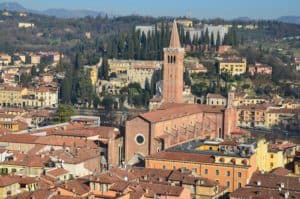Last updated on .
The Basilica of Saint Anastasia (Basilica di Sant’Anastasia) is the largest church in the UNESCO World Heritage listed city of Verona. It’s an amazing place to visit for the quality of the artwork inside. Construction of the basilica started in 1280 and it wasn’t consecrated until 1471.

Admission
Admission is €4 (as of August 2023) but free if you have a Verona Card. The church is open daily. A free audio guide is included in the admission.
Another option for tickets is to pay €8 (as of August 2023) to get access to four churches in Verona, including the Duomo, San Zeno, and San Fermo.
Exterior
The façade of Saint Anastasia remains unfinished. It’s made of brick and has a few fading frescoes above the entrance. There are relief panels to the right of the doors while to the left the space remains empty.
To the left of the façade, above an archway that leads to an inner courtyard, is the tomb of Guglielmo da Castelbarco, who was a member of a noble family and died in 1320. His elegant tomb inspired the della Scala clan’s Scaliger Tombs.
The bell tower, which sits behind the church, stands 72m tall. It contains nine bells that were placed there in 1839.
Interior
Inside the church, you’ll notice six large columns on each side. There’s also a beautifully decorated vaulted ceiling.
Two stoups next to the first two columns are held up by hunchback figures. The one on the left is attributed to Gabriele Caliari (1568-1631) while the one on the right was made by Paolo Orefice.
The rest of the interior is like an art gallery. There are several frescoes on the walls as well as a pipe organ installed in 1937 but reusing the original chest and 16th century choir.
Altar
The main altar is made of marble and was consecrated in 1952. Five stained glass windows behind the altar date back to 1935.
On the left side of the altar is a monument to Cortesia Serego (1335-1386), an Italian general. It was finished in 1432 by Vincenzo di Stefano da Verona and depicts the general on a horse in armor. The sarcophagus has always been empty.
Chapels
There are several side chapels and side altars in the basilica, many with important works of art. One of them contains the tomb of Pietro Cossali (1748-1815), a mathematician who was born in Verona.
The most famous is the Pellegrini Chapel, which contains an important fresco called San Giorgio and the Princess by Pisanello (c. 1380-c. 1450). It was finished around the 1430s. Unfortunately I don’t have a photo.
For me, the most impressive chapel is the Chapel of the Rosary (Cappella del Rosario), which was built between 1585 and 1596 to commemorate Venice’s victory in the Battle of Lepanto in 1571. It contains a stunning Baroque ceiling as well as some paintings and marble statues.
Church of San Pietro Martire
Outside the Basilica of Saint Anastasia is another smaller church, the Church of San Pietro Martire (Chiesa di San Pietro Martire), also known as the Church of San Giorgetto (Chiesa di San Giorgetto). It was built in 1284 and deconsecrated in 1796.
Above the entrance are some frescoes. One of them depicts Saint George slaying a dragon.